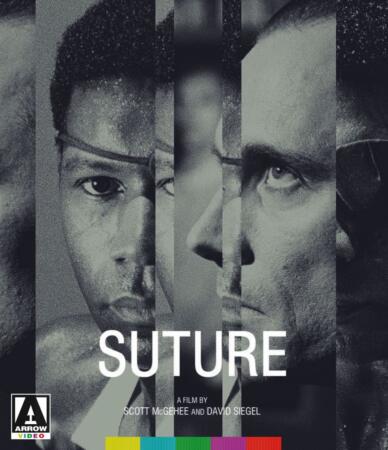“Suture” is a film that we could say defies classification, but is often described as a neo-noir thriller; one that may seem at first to be more concerned with how it looks than with what lies underneath its glossy surface – a theory that wouldn’t be a completely without merit, when one considers that the filmmakers (co-directors Scott McGehee and David Siegel) have a design school background.
But it’s an intriguing concept, one that deals with the existential nature of what we call “Black identity.” If Frantz Fanon was a filmmaker, this may have been something he would’ve created.
In short, wealthy white Vincent (played by Michael Harris) and working class black Clay (played by Dennis Haysbert), are long-lost half-brothers who contact each other after their father’s death. Vincent uses the arrival of Clay to engineer his own death; in a twist, Clay survives only to be burnt beyond recognition, and suffers amnesia. At the hospital, a plastic surgeon reconstructs his face, but based on pictures of Vincent, and a psychiatrist helps reconstruct his personality, and memories. That Vincent is a white man, while Clay is a black man, is lost on everyone else; no one seems to notice the obvious physical differences between the two, and the audience is essentially forced to believe the same.
It’s a confounding plot that has and will inspire lots of analysis… or it might bore you into a deep sleep, as it did for a few of my film school pals. The filmmakers take elements like fear and paranoia, plot devices like amnesia, plastic surgery, and “doubles,” to what seem like fairly logical extremes.
“It’s a suspension of disbelief… but it’s also breaking the fourth wall, an alienating effect that makes the whole process of cinema ultra-real, because you get to experience something outside of the narrative itself,” said co-director David Siegel when the film was first released in 1993.
But it’s that self-consciousness that I think undermines the film, as it begins to border on the absurd.
However, it remains a kind of cool, odd fascination for me; its evocative black & white film stock, pristine instead of gritty as you might expect; and its tongue-in-cheek humor. Although I suspect most will likely be more impressed with the film’s style (even if only for a spell), not its genre-bending, fantastical plot.
Comparisons to the likes of David Lynch, surrealist Luis Bunuel, and even Hitchcock have been made.
It was released in 1993, but never really found an audience, despite critical acclaim. And not-so surprisingly, Steven Soderbergh (as he’s done with other ignored art-house films) later came on-board to serve as executive producer , to help raise its profile.
It’s been available on DVD for years; however, I was informed last night that it’s getting an HD remastering, via an outfit called Arrow Video, and will finally be released on Blu-ray next month, in a “2-Disc Special Edition” – so expect lots and lots of extra features, given you a behind-the-scenes look at the making of the film, including a director’s commentary that should help with your understanding and appreciation of it.
To watch this on a large HD screen again (even better in a theatrical setting), in awe of its glorious, crisp black & white photography, is worth the money.
You can pre-order your copy right now on Amazon.
Here’s a teaser:


